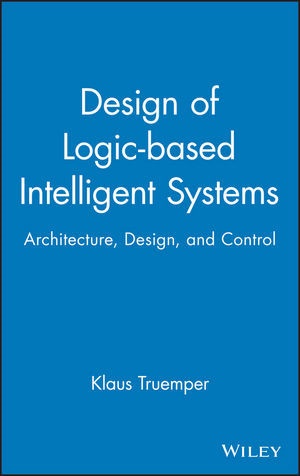Share
Fr. 220.00
Truemper, K Truemper, K. Truemper, Klaus Truemper, Klaus (University of Texas At Dallas Truemper, Truemper Klaus
Design of Logic-Based Intelligent Systems
English · Hardback
Shipping usually within 1 to 3 weeks (not available at short notice)
Description
Informationen zum Autor Klaus Truemper is a professor of computer science at the University of Texas at Dallas. He is the author of two books, including Effective Logic Computation (Wiley, 1998). Klappentext Principles for constructing intelligent systemsDesign of Logic-based Intelligent Systems develops principles and methods for constructing intelligent systems for complex tasks that are readily done by humans but are difficult for machines. Current Artificial Intelligence (AI) approaches rely on various constructs and methods (production rules, neural nets, support vector machines, fuzzy logic, Bayesian networks, etc.). In contrast, this book uses an extension of propositional logic that treats all aspects of intelligent systems in a unified and mathematically compatible manner.Topics include:* Levels of thinking and logic* Special cases: expert systems and intelligent agents* Formulating and solving logic systems* Reasoning under uncertainty* Learning logic formulas from data* Nonmonotonic and incomplete reasoning* Question-and-answer processes* Intelligent systems that construct intelligent systemsDesign of Logic-based Intelligent Systems is both a handbook for the AI practitioner and a textbook for advanced undergraduate and graduate courses on intelligent systems. Included are more than forty algorithms, and numerous examples and exercises. The purchaser of the book may obtain an accompanying software package (Leibniz System) free of charge via the internet at leibnizsystem.com. Zusammenfassung Principles for constructing intelligent systemsDesign of Logic-based Intelligent Systems develops principles and methods for constructing intelligent systems for complex tasks that are readily done by humans but are difficult for machines. Current Artificial Intelligence (AI) approaches rely on various constructs and methods (production rules, neural nets, support vector machines, fuzzy logic, Bayesian networks, etc.). In contrast, this book uses an extension of propositional logic that treats all aspects of intelligent systems in a unified and mathematically compatible manner.Topics include:* Levels of thinking and logic* Special cases: expert systems and intelligent agents* Formulating and solving logic systems* Reasoning under uncertainty* Learning logic formulas from data* Nonmonotonic and incomplete reasoning* Question-and-answer processes* Intelligent systems that construct intelligent systemsDesign of Logic-based Intelligent Systems is both a handbook for the AI practitioner and a textbook for advanced undergraduate and graduate courses on intelligent systems. Included are more than forty algorithms, and numerous examples and exercises. The purchaser of the book may obtain an accompanying software package (Leibniz System) free of charge via the internet at leibnizsystem.com. Inhaltsverzeichnis Preface. Chapter 1. Introduction. PART I: LOGIC PROBLEMS. Chapter 2. Introduction to Logic and Problems SAT and MINSAT. Chapter 3. Variations of SAT and MINSAT. Chapter 4. Quantified SAT and MINSAT. PART II: FORMULATION OF LOGIC SYSTEMS. Chapter 5. Basic Formulation Techniques. Chapter 6. Uncertainty. PART III: LEARNING. Chapter 7. Learning Formulas. Chapter 8. Accuracy of Learning Formulas. PART IV: ADVANCED REASONING. Chapter 9. Nonmonotonic and Incomplete Reasoning. Chapter 10. Question-and-Answer Processes. PART V: APPLICATIONS. Chapter 11. Applications. References. Author Index. Subject Index. ...
List of contents
Preface.
Chapter 1. Introduction.
PART I: LOGIC PROBLEMS.
Chapter 2. Introduction to Logic and Problems SAT and MINSAT.
Chapter 3. Variations of SAT and MINSAT.
Chapter 4. Quantified SAT and MINSAT.
PART II: FORMULATION OF LOGIC SYSTEMS.
Chapter 5. Basic Formulation Techniques.
Chapter 6. Uncertainty.
PART III: LEARNING.
Chapter 7. Learning Formulas.
Chapter 8. Accuracy of Learning Formulas.
PART IV: ADVANCED REASONING.
Chapter 9. Nonmonotonic and Incomplete Reasoning.
Chapter 10. Question-and-Answer Processes.
PART V: APPLICATIONS.
Chapter 11. Applications.
References.
Author Index.
Subject Index.
Report
"....both a handbook for the AI practitioner and a textbook foradvanced undergraduate and graduate courses on intelligentsystems." ( International Journal of General Systems , June2005)
"...extremely well-written and insightful and haseducational benefits even for those not intending to use thematerial directly." ( IIE Transactions-OperationsEngineering , March 2005)
"...the book reads well and can be highly recommended."( Journal of Intelligent & Fuzzy Systems , Vol. 16, No. 3,2005)
"...will greatly interest you and your advancedstudents...a useful book." ( Computing Reviews.com ,February 16, 2005)
"...extremely well written and insightful and has educationbenefits even for those not intending to use the materialdirectly." ( IIE Transactions on Operations Engineering )
"Truemper offers definitive, state-of-the art coverage of thisarea." ( CHOICE , November 2004)
"...the author s novel approach has something going for it,and that some good examples of intelligent reasoning can beachieved by fitting them into the author s model." ( ComputingReviews.com , August 2, 2004)
Product details
| Authors | Truemper, K Truemper, K. Truemper, Klaus Truemper, Klaus (University of Texas At Dallas Truemper, Truemper Klaus |
| Publisher | Wiley, John and Sons Ltd |
| Languages | English |
| Product format | Hardback |
| Released | 15.06.2004 |
| EAN | 9780471484035 |
| ISBN | 978-0-471-48403-5 |
| No. of pages | 366 |
| Subjects |
Natural sciences, medicine, IT, technology
> Technology
> Electronics, electrical engineering, communications engineering
Electrical & Electronics Engineering, Elektrotechnik u. Elektronik, Intelligente Systeme u. Agenten, Intelligent Systems & Agents, Intelligente Systeme |
Customer reviews
No reviews have been written for this item yet. Write the first review and be helpful to other users when they decide on a purchase.
Write a review
Thumbs up or thumbs down? Write your own review.

